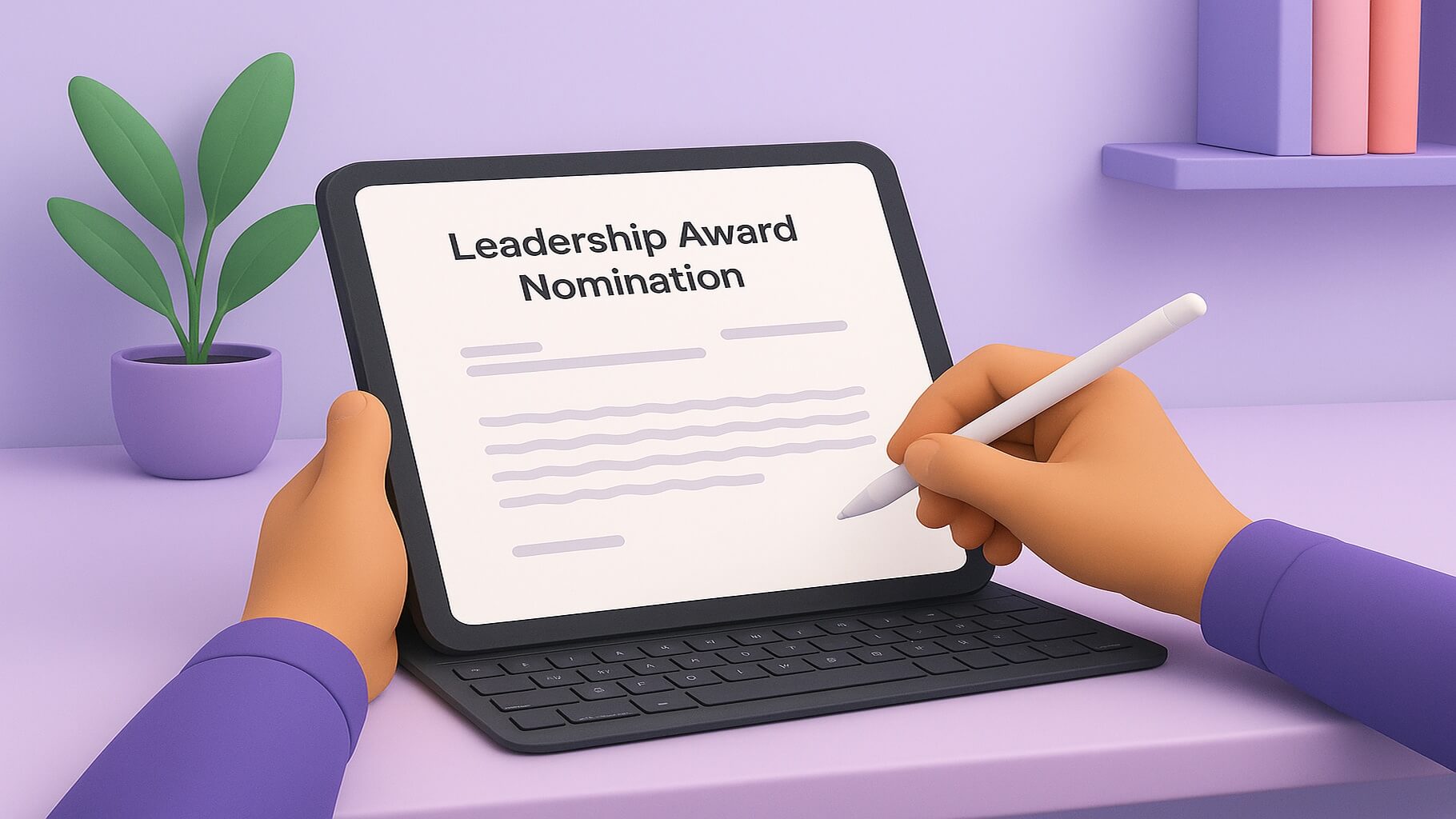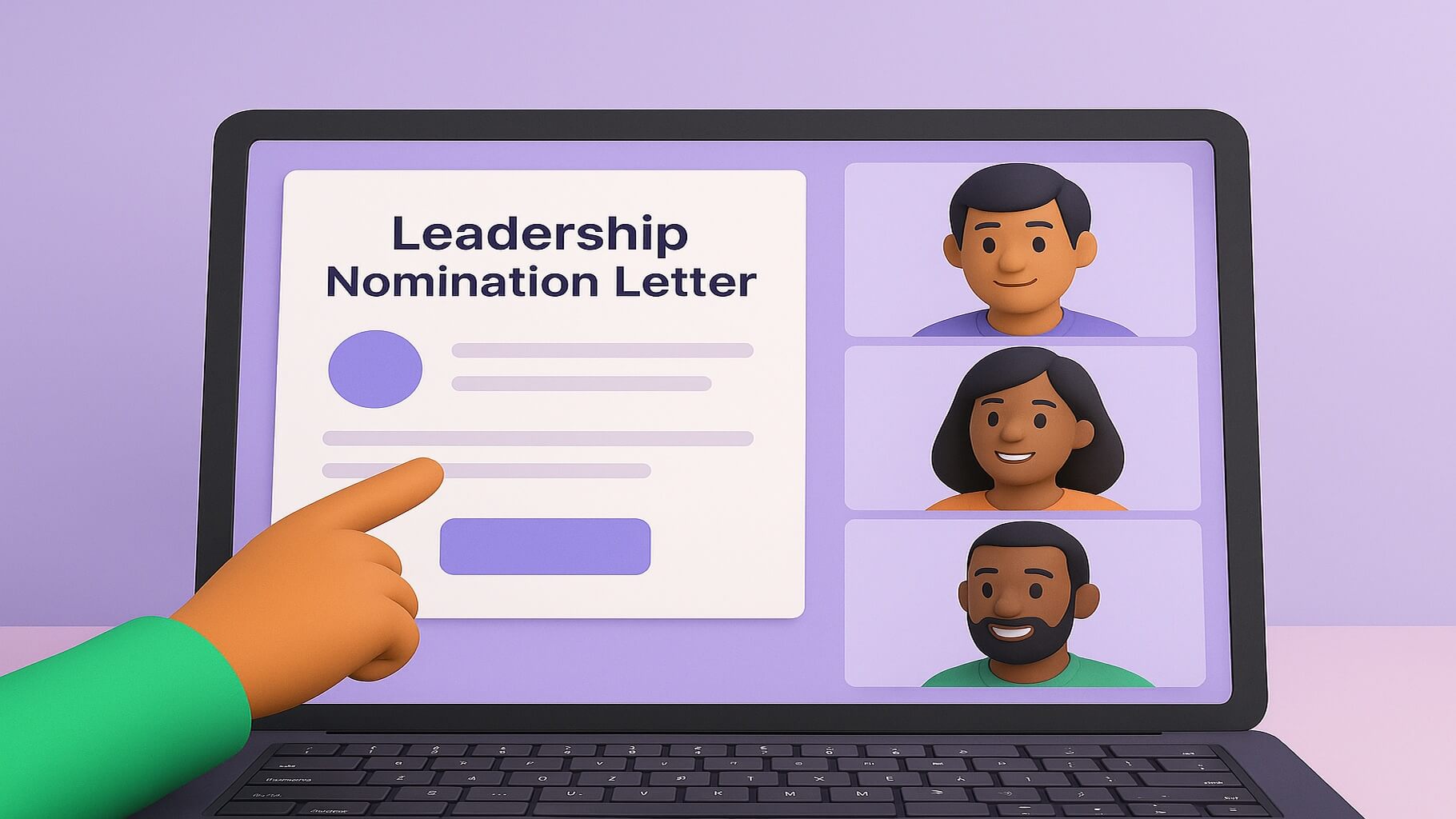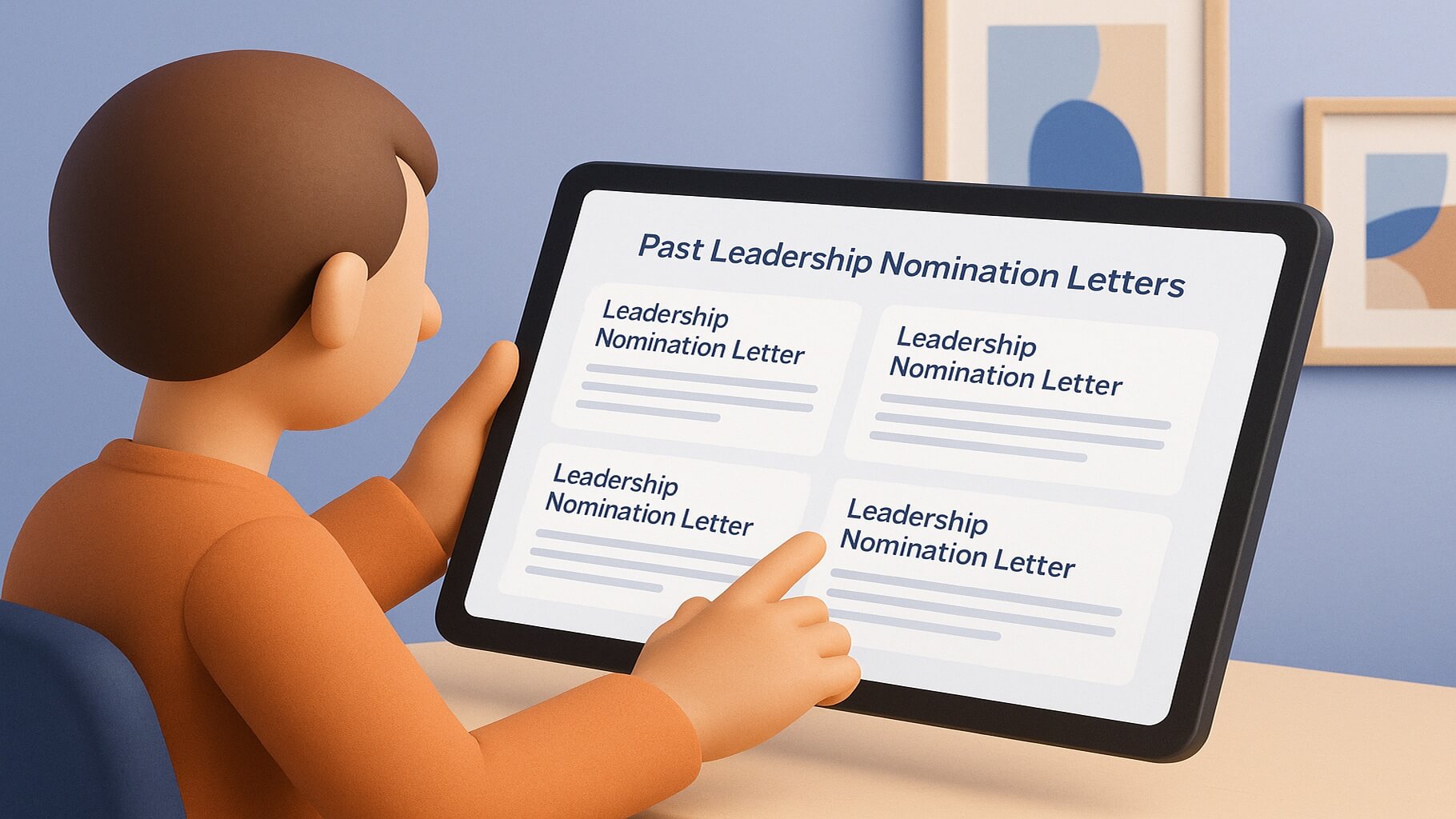
Writing an effective nomination letter for leadership award programs requires more than good intentions. It demands strategic thinking, clear communication, and compelling evidence that showcases a nominee's exceptional leadership qualities. Many organizations struggle with creating nomination letters that truly capture a candidate's impact and inspire committee members to recognize outstanding contributions.
The nomination process becomes significantly more manageable when you have proven templates, concrete examples, and structured approaches to guide your writing efforts. Whether you're nominating a colleague for recognition or developing a comprehensive nomination letter for a leadership award template for your organization, the right resources can transform how you approach leadership recognition. Matter's recognition platform helps organizations identify potential nominees through peer appreciation data while building cultures where exceptional leadership naturally emerges and receives acknowledgment. This guide provides 49 practical examples and templates to help you create compelling nomination letters that achieve their desired outcome.
What are leadership awards?

Leadership awards represent formal recognition programs designed to acknowledge individuals who demonstrate exceptional leadership qualities, drive meaningful change, and inspire others through their actions and dedication. These recognition programs serve as essential tools for organizations to highlight excellence, reinforce company values, and motivate employees to strive for outstanding performance in their roles.
Understanding different types of leadership awards in organizations
Organizations develop diverse award categories to capture the full spectrum of leadership excellence across different roles, levels, and contributions. These varied recognition approaches ensure that multiple leadership styles receive appropriate acknowledgment and celebration.
Common types of leadership awards include:
- Executive leadership awards that honor senior-level managers guiding strategic initiatives and organizational transformation
- Emerging leader recognition focuses on employees who demonstrate promising leadership potential in their early career stages.
- Team leadership awards celebrate individuals who excel at motivating groups and fostering collaboration.
- Industry-specific leadership awards addressing unique challenges and achievements within particular sectors
Organizations typically establish multiple award categories to recognize diverse leadership styles and contributions across different levels and departments. Executive leadership awards honor senior-level managers who guide strategic initiatives and organizational transformation. Emerging leader recognition focuses on employees who show promising leadership potential despite being in early career stages.
Industry-specific leadership awards address unique challenges and achievements within particular sectors. Innovation leadership recognition highlights individuals who drive creative solutions and technological advancement. Community leadership awards acknowledge those who extend their influence beyond workplace boundaries to create positive social impact.
How leadership awards examples recognize exceptional leadership qualities
Effective leadership recognition programs focus on measurable outcomes and specific behaviors that demonstrate genuine leadership impact. These evaluation approaches help organizations identify leaders who create lasting positive change while inspiring others to develop similar capabilities.
Key recognition criteria include:
- Specific behaviors and measurable outcomes rather than general personality traits or characteristics
- Evidence of initiative and problem-solving skills that demonstrate a proactive leadership approach
- Capacity to develop other team members through mentoring, coaching, and skill-building activities
- Excellence in communication and decision-making under pressure and complex organizational challenges
Effective leadership awards examples focus on specific behaviors and measurable outcomes rather than general personality traits. These recognition programs evaluate candidates based on their ability to inspire others, drive results, and demonstrate consistency in their leadership approach. Committee members look for evidence of initiative, problem-solving skills, and the candidate's capacity to develop other team members.
The evaluation process considers both quantitative achievements and qualitative leadership traits. Successful nominees typically demonstrate excellence in communication, decision-making under pressure, and the ability to navigate complex organizational challenges. Recognition programs also value leaders who embody organizational culture and serve as positive role models for their colleagues.
Benefits of leadership awards examples for workplace culture and development
Leadership recognition programs generate positive organizational changes that extend far beyond individual award recipients. These systematic appreciation efforts help establish cultural norms while encouraging widespread leadership development throughout the organization.
Cultural and development benefits include:
- Clear expectations for leadership behavior that help employees understand organizational values and priorities
- Strengthened employee engagement through visible investment in identifying and celebrating talent
- Mentorship and champion development as award recipients inspire and guide other employees
- Enhanced workplace relationships through nomination processes that encourage appreciation and observation
Leadership awards create ripple effects throughout organizations by establishing clear expectations for leadership behavior and performance. When employees see colleagues receiving recognition for specific leadership qualities, they understand what the organization values and strive to develop similar characteristics. This process naturally elevates overall leadership standards across all departments.
These recognition programs also strengthen employee engagement by demonstrating that the organization invests in identifying and celebrating talent. Award recipients often become mentors and champions for others, creating a culture where leadership development becomes a shared responsibility. The nomination process itself encourages employees to observe and appreciate leadership qualities in their colleagues, fostering deeper workplace relationships similar to those seen in an example nomination letter for employee of the month programs.
Why do nominations for leadership awards matter

The nomination process serves as the foundation for identifying exceptional leaders and ensuring recognition programs maintain their integrity and value. Without thoughtful nominations, even the best-designed leadership awards lose their impact and fail to recognize truly deserving candidates. Quality nominations provide committee members with the detailed information needed to make informed decisions about award recipients.
Impact of nomination letter for leadership award processes on recognition quality
Well-structured nomination processes ensure that leadership awards recognize individuals who truly deserve recognition based on their contributions and impact. When nominators follow clear guidelines and provide comprehensive information, committee members can evaluate candidates fairly and consistently. This systematic approach prevents awards from becoming popularity contests or political decisions.
The nomination letter serves as the primary vehicle for presenting a candidate's qualifications and achievements to the selection committee. A compelling letter can elevate a deserving candidate who might otherwise be overlooked. At the same time, a poorly written submission can diminish even the strongest candidate's chances. Employee nomination examples demonstrate how effective nomination strategies contribute to successful recognition outcomes.
Strong nomination letters also create lasting records of excellence that organizations can reference for future leadership development and succession planning. These documents become valuable resources for understanding what leadership qualities drive success within specific organizational contexts.
Benefits of structured leadership award nomination letter samples for fair evaluation
Structured nomination letter formats create significant advantages for both nominators and evaluation committees by establishing consistent standards and processes. These standardized approaches ensure fairness while improving the overall quality of nomination submissions and committee decision-making.
Key benefits of structured nomination letter formats include:
- Equal consideration for all candidates through standardized criteria and evidence requirements that eliminate bias
- Comprehensive evaluation framework that guides nominators through essential components and supporting evidence
- Streamlined review process that presents information in predictable formats for efficient committee evaluation
- Improved submission quality by helping inexperienced nominators create effective letters through structured guidance
Standardized nomination letter formats ensure that all candidates receive equal consideration by requiring nominators to address the same key criteria and provide similar types of supporting evidence. This consistency enables committee members to compare nominees objectively and reduces the likelihood that bias will influence selection decisions.
Structured templates guide nominators through the essential components of effective letters, including specific examples of leadership behavior, measurable achievements, and detailed descriptions of the nominee's impact on their team and organization. This framework helps nominators who may lack experience writing formal letters while ensuring comprehensive candidate evaluation, similar to the approaches used in employee-of-the-year nomination processes.
The standardization also streamlines the review process for committee members by presenting information in predictable formats. This organization allows evaluators to focus on content quality rather than struggling to locate essential details within varying letter structures.
How nomination letter examples improve leadership award program effectiveness
Providing concrete examples of successful nomination letters helps potential nominators understand expectations and quality standards for submissions. These samples demonstrate how to present candidate information persuasively while maintaining a professional tone and appropriate levels of detail. Effective examples show nominators how to balance factual information with compelling narrative elements.
Quality nomination letter examples also illustrate different approaches for various award categories and leadership levels. A letter for an emerging leader might emphasize potential and growth trajectory. At the same time, an executive nomination would focus on strategic impact and organizational transformation. Employee nomination sample resources provide valuable frameworks for different recognition scenarios.
These examples serve as training tools that improve the overall quality of submissions over time. As nominators become more skilled at crafting compelling letters, the entire program benefits from higher-quality candidates and more thorough evaluations.
15 nomination letter for leadership award examples by category

Effective nomination letters must be tailored to specific award categories and leadership levels to maximize their impact on selection committees. Different leadership positions require different approaches to highlighting relevant qualifications and achievements. Understanding these distinctions ensures that your nomination letter resonates with evaluators and positions your nominee for success.
5 executive leadership award nomination letter samples
Example 1: Strategic transformation leader
This nominee transformed organizational operations through innovative process improvements and strategic vision. Their leadership during a major restructuring initiative resulted in improved efficiency across all departments while maintaining employee morale and engagement. The candidate demonstrated exceptional communication skills by facilitating smooth transitions and ensuring stakeholder buy-in throughout the change process.
Example 2: Financial performance driver
The nominee consistently delivered exceptional financial results while developing sustainable growth strategies for long-term organizational success. Their ability to balance short-term pressures with strategic planning enabled the organization to weather economic challenges and emerge stronger. Committee members will appreciate specific metrics and measurable outcomes that demonstrate quantifiable leadership impact.
Example 3: Culture champion executive
This candidate created a workplace environment that attracts top talent and retains high-performing employees through authentic leadership and genuine care for team member development. Their commitment to fostering inclusive practices and supporting professional growth has enhanced organizational reputation and competitive advantage. The nomination letter should describe specific culture initiatives and their measurable impact on employee satisfaction.
Example 4: Innovation catalyst
The nominee drives technological advancement and creative problem-solving initiatives that position the organization as an industry leader. Their ability to identify emerging opportunities and mobilize resources for innovation projects demonstrates forward-thinking leadership. Supporting evidence should include specific examples of successful innovation initiatives and their business impact.
Example 5: Stakeholder relationship builder
This executive excels at developing strategic partnerships and maintaining positive relationships with key stakeholders across multiple constituencies. Their diplomatic approach and consensus-building skills enable them to navigate complex negotiations and achieve collaborative agreements. The nomination should highlight specific relationship-building achievements and their contribution to organizational objectives.
5 emerging leader nomination letter for leadership award examples
Example 6: Cross-functional collaboration specialist
This emerging leader demonstrates exceptional ability to work across departmental boundaries and build bridges between different teams and functions. Despite being relatively new to leadership roles, they consistently facilitate successful project outcomes by leveraging diverse perspectives and expertise. Their collaborative approach has become a model for other emerging leaders.
Example 7: Mentorship and development advocate
The nominee actively invests in developing other team members and creating learning opportunities for colleagues at all levels. Their dedication to sharing knowledge and developing skills has sped up team performance and produced a culture of constant improvement. Specific examples should illustrate their impact on individual development and team capabilities.
Example 8: Problem-solving innovator
This candidate approaches challenges with creativity and analytical thinking that lead to breakthrough solutions and improved processes. Their capacity to find the fundamental causes of problems and come up with long-term solutions shows that they are mature leaders who think beyond their level of expertise. The letter should provide concrete examples of problems solved and results achieved.
Example 9: Change management facilitator
The nominee shows a natural ability to help teams navigate transitions and adapt to new circumstances with minimal disruption. Their emotional intelligence and communication skills enable the smooth implementation of organizational changes. Supporting evidence should demonstrate their role in successful change initiatives and positive team outcomes.
Example 10: Customer-focused leader
This emerging leader consistently prioritizes customer needs and develops solutions that enhance satisfaction and loyalty. Their understanding of customer perspectives influences decision-making and drives service improvements across the organization. Employee rewards program initiatives often benefit from leaders who understand customer impact.
5 team leadership award nomination examples
Example 11: Performance optimization specialist
The nominee consistently elevates team performance through strategic coaching, resource allocation, and process improvements that maximize productivity while maintaining quality standards. Their systematic approach to team development has resulted in measurable improvements in key performance indicators. Committee members should see specific metrics demonstrating team advancement under their leadership.
Example 12: Conflict resolution expert
This candidate demonstrates exceptional ability to address team conflicts constructively and restore productive working relationships. Their mediation skills and emotional intelligence enable them to navigate sensitive situations while maintaining team cohesion and morale. The nomination should include specific examples of successful conflict resolution and resulting team improvements.
Example 13: Diversity and inclusion champion
The nominee actively promotes inclusive practices and ensures all team members feel valued and heard, regardless of their background or perspective. Their commitment to diversity has enhanced team creativity and decision-making capabilities. Supporting evidence should demonstrate specific diversity initiatives and their positive impact on team dynamics.
Example 14: Skills development coordinator
This team leader excels at identifying individual strengths and development opportunities while creating personalized growth plans for each team member. Their investment in people development has resulted in improved retention and internal promotion rates. The letter should highlight specific development successes and career advancement outcomes.
Example 15: Results-driven motivator
The nominee consistently inspires teams to exceed expectations through clear goal setting, regular feedback, and recognition of achievements. Their ability to maintain team motivation during challenging periods demonstrates resilient leadership qualities. Employee recognition strategies often feature leaders who excel at motivating others.
12 sample nomination letters for leadership award formats

Successful nomination letters follow established formats that present information logically and persuasively while addressing all evaluation criteria. Different format approaches serve various purposes and cater to different audience preferences, ranging from formal committee presentations to peer-driven nominations. Understanding these format options helps nominators choose the most appropriate structure for their specific situation.
4 formal nomination letter for leadership award templates
Template 1: Traditional business format
This structured approach begins with formal letterhead and addresses the selection committee directly. The opening paragraph states the nomination purpose and identifies the specific award category. Body paragraphs systematically address evaluation criteria with supporting evidence and concrete examples. The conclusion summarizes key qualifications and requests favorable consideration.
The format emphasizes professionalism and completeness, making it ideal for executive-level nominations and formal recognition programs. Each section flows logically to the next, building a comprehensive case for the nominee's qualifications. Committee members appreciate this organized approach when evaluating multiple candidates.
Template 2: Executive summary style
This format leads with a compelling executive summary that highlights the nominee's most significant achievements and leadership qualities. Subsequent sections provide detailed evidence supporting the summary claims. This approach works particularly well for busy committee members who need to quickly grasp a candidate's qualifications.
The structure allows nominators to lead with their strongest points while ensuring comprehensive coverage of all evaluation criteria. Supporting details reinforce the initial summary without overwhelming readers with excessive information. Clear section headings guide readers through the content efficiently.
Template 3: Achievement-focused presentation
This template organizes content around specific achievement categories relevant to the award criteria. Each section addresses a distinct aspect of leadership performance, providing detailed examples and measurable outcomes. The format works effectively for nominees with diverse accomplishments across multiple areas.
Quantitative data and specific metrics support qualitative descriptions of leadership behavior and impact. This combination provides committee members with both emotional appeal and factual evidence for their evaluation process. Charts or bullet points can enhance readability and impact.
Template 4: Chronological leadership journey
This format presents the nominee's leadership development and achievements in chronological order, showing progression and growth over time. The approach works well for emerging leaders or nominees with clear advancement trajectories. Each time period highlights relevant accomplishments and increasing levels of responsibility.
The chronological structure helps committee members understand how the nominee developed their current capabilities and leadership philosophy. This format is particularly suited to employee nomination processes that value both growth potential and current performance.
4 peer-submitted leadership award nomination letter samples
Sample 1: Collaborative colleague perspective
This peer nomination highlights the nominee's ability to work effectively with others and foster positive working relationships throughout the organization. The letter describes specific instances of collaboration and the nominee's contribution to team success. Colleagues can provide unique insights into daily leadership behaviors that supervisors might not observe.
The tone remains professional while incorporating personal observations about the nominee's character and work ethic. Peer nominators can speak authentically about the nominee's impact on workplace culture and team morale. This perspective adds credibility and depth to the overall nomination package.
Sample 2: Cross-departmental impact witness
This format highlights the nominee's influence beyond their immediate team or department, demonstrating broad organizational impact. The peer nominator describes projects or initiatives where they observed the nominee's leadership from a different departmental perspective. This external viewpoint provides valuable validation of the nominee's reputation and effectiveness.
Specific examples illustrate how the nominee's leadership positively affected other departments or functions. The letter stresses how important it is to work together, communicate well, and be able to work well with people from other organizations. Committee members value this broader perspective on candidate qualifications.
Sample 3: Mentee testimonial approach
This nomination comes from someone who has been mentored or developed by the nominee, providing firsthand evidence of their leadership and development capabilities. The letter describes specific ways the nominee invested in the nominator's professional growth and the results of that investment.
Personal growth stories and career advancement achievements demonstrate the nominee's commitment to developing others. This perspective highlights leadership qualities that may not be readily apparent in traditional performance metrics but are essential for effective leadership. The emotional connection adds authenticity to the nomination.
Sample 4: Project team member perspective
This peer nomination focuses on the nominee's leadership during specific projects or initiatives where the nominator served as a team member. The letter provides detailed examples of leadership behaviors, decision-making processes, and team management skills observed during collaborative work.
The format emphasizes practical leadership applications and real-world problem-solving abilities. Specific project outcomes and the nominee's role in achieving success provide concrete evidence of leadership effectiveness. Employee rewards programs often recognize this type of collaborative leadership excellence.
4 employee-recommended nomination letter examples
Example 1: Direct report recommendation
This nomination originates from an employee who reports directly to the nominee, offering valuable insights into the nominee's daily leadership practices and management effectiveness. The letter provides specific examples of supportive leadership, professional development opportunities, and the creation of a positive team culture.
Direct reports can authentically speak about the nominee's ability to motivate, guide, and develop team members. Their perspective carries significant weight because they experience the nominee's leadership approach firsthand. The letter should strike a balance between personal appreciation and professional observations about leadership capabilities.
Example 2: Skip-level employee perspective
This format presents a nomination from an employee who doesn't report directly to the nominee but has observed their leadership impact across the organization. The letter emphasizes the nominee's reputation, visibility, and influence beyond their immediate team.
Skip-level perspectives demonstrate the nominee's broader organizational impact and leadership presence. These nominators can attest to the nominee's role in fostering a positive workplace culture and inspiring employees throughout the organization. The external viewpoint adds credibility to claims about leadership effectiveness.
Example 3: New employee integration advocate
This nomination highlights the nominee's ability to welcome and integrate new team members, demonstrating inclusive leadership and commitment to team development. The letter outlines specific actions taken to support new employees in their success and sense of value within the organization.
New employee experiences provide valuable insights into the nominee's leadership character and values. These situations often reveal authentic leadership qualities because they involve voluntary efforts to support others. The nomination should include specific examples of integration support and resulting positive outcomes.
Example 4: Performance improvement supporter
This employee suggestion is based on the nominee's ability to help team members who are having trouble do better and feel better about themselves. The letter describes the nominee's patient approach, specific support strategies, and successful outcomes achieved through their leadership intervention.
Performance improvement scenarios demonstrate the nominee's commitment to developing all team members, not just high performers. This perspective highlights important leadership qualities, such as empathy, persistence, and the ability to provide constructive feedback. Employee recognition and rewards systems often value leaders who invest in all team members, recognizing their efforts to support and develop the entire team.
10 leadership award examples with nomination letter templates

Comprehensive leadership award programs require diverse recognition categories that acknowledge different types of excellence and leadership contributions. Each award category serves specific purposes and recognizes unique qualities that contribute to organizational success. Understanding these distinctions helps nominators select appropriate awards and craft targeted nomination letters.
4 innovation leadership award nomination examples
Example 1: Technology advancement pioneer
This nominee drives technological innovation that transforms organizational capabilities and competitive positioning. Their visionary approach to emerging technologies has resulted in significant operational improvements and new revenue opportunities. The nomination letter should detail specific innovations implemented and their measurable business impact.
To be a good technical leader, you need to be able to take risks, plan strategically, and explain difficult ideas to a wide range of people. The nominee demonstrates these capabilities through successful technology initiatives and team development in technical areas. Supporting evidence should include project outcomes, adoption rates, and user feedback.
Example 2: Process improvement innovator
The candidate consistently identifies opportunities to streamline operations and eliminate inefficiencies through creative problem-solving and systematic analysis. Their innovative approaches to workflow optimization have reduced costs while improving quality and customer satisfaction. The nomination should provide specific examples of process improvements and quantified results.
Process innovation leadership combines analytical skills with creative thinking to develop solutions that others might overlook. The nominee's ability to engage teams in improvement initiatives and maintain momentum during implementation demonstrates exceptional change management capabilities. Documentation should include before-and-after comparisons and stakeholder feedback.
Example 3: Product development leader
This nominee leads innovative product development initiatives that meet emerging customer needs and expand market opportunities. Their customer-focused approach and collaborative development process have led to successful product launches and a positive market reception. The letter should highlight specific products developed and their commercial success.
Product innovation requires striking a balance between creativity and practical constraints, including budget limitations, timeline pressures, and technical feasibility. The nominee demonstrates mastery of these challenges while maintaining team motivation and stakeholder confidence throughout development cycles. Supporting evidence should include market performance data and customer satisfaction metrics.
Example 4: Cultural innovation champion
The candidate pioneers innovative approaches to workplace culture and employee engagement, enhancing organizational effectiveness and employee satisfaction. Their innovative programs and initiatives have become models for other departments and organizations. Employee rewards platform solutions often recognize leaders who drive cultural innovation.
Cultural innovation leadership requires emotional intelligence, communication skills, and a deep understanding of human motivation. The nominee creates programs that resonate with diverse employee populations while supporting business objectives. Documentation should include participation rates, satisfaction surveys, and cultural assessment results.
3 community leadership nomination letter samples
Example 5: Volunteer organization coordinator
This nominee dedicates significant personal time to coordinating volunteer efforts that benefit community organizations and address local needs. Their leadership has mobilized resources and volunteers to create meaningful impact beyond workplace responsibilities. The nomination should describe specific volunteer initiatives and their community benefit.
Community leadership demonstrates values alignment and a commitment to social responsibility, which enhances the nominee's credibility and influence. Their ability to organize volunteers and coordinate complex community projects showcases transferable leadership skills valuable in professional settings. Evidence should include volunteer participation numbers and community impact measurements.
Example 6: Educational partnership builder
The candidate develops strategic partnerships between the organization and educational institutions that create learning opportunities and support workforce development. Their initiative has strengthened community relationships while addressing skill gaps and career development needs. The letter should outline the partnership's achievements and educational outcomes.
Educational leadership requires vision, patience, and a commitment to building long-term relationships that may not yield immediate benefits. The nominee demonstrates these qualities through sustained engagement with educational partners and measurable improvements in program effectiveness. Supporting documentation should include partnership agreements and student success metrics.
Example 7: Social impact advocate
This nominee champions social causes and leads initiatives that address community challenges while engaging employees in meaningful volunteer opportunities. Their advocacy has raised awareness and resources for important social issues while strengthening organizational reputation. Employee recognition platform systems often highlight leaders who drive social impact.
Social advocacy leadership combines passion with strategic thinking to create sustainable programs that benefit communities while engaging employees. The nominee strikes a balance between advocacy and professional responsibilities, maintaining credibility with diverse stakeholder groups. Evidence should include fundraising results, volunteer participation, and community feedback.
3 transformational leadership awards examples
Example 8: Organizational restructuring leader
The nominee successfully guided the organization through major structural changes while maintaining employee morale and operational effectiveness. Their communication strategy and change management approach minimized disruption while achieving strategic objectives. The nomination should describe the scope of the transformation and the positive outcomes achieved.
Transformational leadership during restructuring requires exceptional communication skills, emotional intelligence, and strategic thinking. The nominee demonstrates these capabilities through successful change implementation and sustained employee engagement throughout transition periods. Supporting evidence should include employee satisfaction data and operational performance metrics.
Example 9: Digital transformation champion
This candidate leads comprehensive digital transformation initiatives that modernize organizational systems and processes. Their strategic vision and implementation expertise have positioned the organization for future success while improving current operations. The letter should detail digital initiatives implemented and their business impact.
Digital transformation leadership combines technical understanding with change management expertise to guide organizations through complex technology adoptions. The nominee strikes a balance between innovation and risk management, ensuring user adoption and sustainable implementation. Documentation should include system performance data and user satisfaction surveys.
Example 10: Cultural transformation architect
The nominee designs and implements comprehensive culture change initiatives that align employee behaviors with organizational values and strategic objectives. Their systematic approach has created lasting cultural improvements that support business success. Peer-to-peer recognition programs often emerge from successful cultural transformation efforts.
Cultural transformation requires a deep understanding of human psychology, organizational dynamics, and change management principles. The nominee creates sustainable culture change through a systematic approach and consistent reinforcement of desired behaviors. Evidence should include culture assessment results, employee engagement scores, and behavioral change indicators.
12 nomination form examples for leadership awards

Well-designed nomination forms streamline the submission process while ensuring nominators provide all essential information needed for fair candidate evaluation. Effective forms balance comprehensiveness with user-friendliness, guiding nominators through required sections without overwhelming them with excessive complexity. The best nomination forms produce consistent, high-quality submissions that enable objective candidate comparison.
5 structured nomination form templates for leadership recognition
Template 1: Comprehensive leadership evaluation form
This structured approach divides nomination requirements into specific categories, including leadership competencies, achievement examples, and supporting evidence. Each section provides clear instructions and examples to guide nominators through the submission process. The format ensures comprehensive candidate evaluation while maintaining consistency across submissions.
The form includes fields for nominee information, nominator credentials, and detailed responses to evaluation criteria. Specific prompts help nominators provide concrete examples and measurable outcomes that support their candidate. This structure yields thorough nominations that provide committee members with complete information for informed decision-making.
Template 2: Competency-based assessment format
This template organizes questions around specific leadership competencies relevant to the award category. Nominators rate candidates on various leadership dimensions while providing supporting evidence for their assessments. The competency framework ensures consistent evaluation criteria across all nominations.
Each competency section includes a definition, behavioral indicators, and space for specific examples demonstrating the nominee's capabilities. This approach helps nominators understand evaluation expectations while providing committee members with standardized information for comparison purposes. Rating scales combined with narrative descriptions create balanced candidate portraits.
Template 3: Achievement-focused submission structure
This form emphasizes specific achievements and measurable outcomes while providing context for understanding their significance. Nominators describe major accomplishments, their impact on the organization, and the nominee's role in achieving success. The achievement focus helps committee members evaluate concrete contributions.
Supporting sections address leadership style, team impact, and professional development while maintaining emphasis on results and outcomes. This balance provides comprehensive candidate information while highlighting practical leadership effectiveness. Quantitative data fields ensure objective measurement possibilities.
Template 4: 360-degree feedback integration format
This advanced template incorporates input from multiple perspectives, including supervisors, peers, and direct reports. The form structure accommodates different viewpoints while maintaining consistency in evaluation criteria. This comprehensive approach provides committee members with well-rounded assessments of candidates.
Separate sections address different relationship perspectives while maintaining focus on leadership effectiveness and impact. The template includes coordination instructions for gathering multiple inputs and synthesizing them into coherent nominations. This format works particularly well for senior leadership positions.
Template 5: Project-based leadership demonstration
This template focuses on specific projects or initiatives where the nominee demonstrated exceptional leadership capabilities. Nominators describe project challenges, leadership approaches, and outcomes achieved through the nominee's guidance. The project focus provides a concrete context for evaluating leadership effectiveness.
Detailed project sections address planning, execution, team management, and results while highlighting the nominee's specific contributions. This format is effective in recognizing leadership during significant organizational initiatives or challenging situations. Supporting documentation requirements ensure the presentation of thorough evidence.
4 simplified leadership award nomination forms
Form 1: Essential information capture
This streamlined method focuses on the most important nomination information while making it easier for nominators to do their jobs. The form includes basic nominee details, achievement highlights, and supporting rationale without excessive complexity. This simplicity encourages broader participation in nomination processes.
Key sections address primary qualifications, specific examples, and impact statements while maintaining professional standards. The simplified structure makes nomination accessible to busy professionals while ensuring adequate information for evaluation purposes. Clear instructions help nominators provide quality submissions despite the streamlined format.
Form 2: Quick nomination submission
This efficient format enables rapid submission of nominations for time-sensitive recognition programs or busy nomination periods. The form captures essential candidate information and key supporting points, eliminating the need for extensive narrative requirements. This approach is particularly effective for programs with high nomination volumes.
Structured fields guide nominators through required information while checkbox options and dropdown menus accelerate completion. The quick format maintains evaluation standards while reducing submission barriers that might discourage participation. Brief explanation fields provide the necessary detail without overwhelming nominators.
Form 3: Peer nomination focus
This simplified template specifically supports peer nominations by providing appropriate language and examples for colleague-to-colleague recognition. The form acknowledges the unique perspective peers bring while ensuring comprehensive candidate evaluation. Peer-friendly instructions encourage authentic, detailed submissions.
Sections address observable leadership behaviors, collaboration effectiveness, and peer influence while maintaining professional nomination standards. The format recognizes that peers may lack access to certain information while emphasizing areas where they have direct knowledge. Employee of the month nomination example templates often use similar peer-focused approaches.
Form 4: Department-level recognition
This template supports departmental leadership recognition programs with simplified requirements appropriate for local-level awards. The form addresses department-specific leadership needs while maintaining a connection to broader organizational values. This localized approach encourages recognition at multiple organizational levels.
Department-focused sections address local impact, team development, and operational improvements while connecting to organizational objectives. The simplified structure enables departments to recognize excellence without extensive administrative requirements. Clear guidance helps ensure consistent standards across different departments.
3 digital nomination form best practices for leadership awards
Practice 1: User experience optimization
Digital forms should prioritize intuitive navigation and clear instructions that guide nominators through submission requirements without confusion. Progressive disclosure techniques reveal sections as needed while progress indicators show completion status. Mobile-responsive design ensures accessibility across different devices and platforms.
Automatic save functionality prevents data loss while smart validation provides real-time feedback on required fields and format requirements. These features reduce nominator frustration while improving submission quality. User testing helps identify potential problems before deploying the form.
Practice 2: Integration and automation capabilities
Modern digital forms should integrate seamlessly with existing systems to facilitate smooth data flow and minimize administrative burdens. Automated workflows can route submissions for review, send confirmation emails, and trigger follow-up actions. Integration with employee databases can pre-populate known information fields, saving time and effort.
Automated deadline reminders and submission confirmations improve the nomination process for both nominators and administrators. Digital signatures and approval workflows streamline processing while maintaining security and accountability. These capabilities reduce manual work while improving process reliability.
Practice 3: Analytics and reporting features
Digital forms should capture data in formats that enable comprehensive analysis and reporting on nomination patterns, submission quality, and program effectiveness. Dashboard views provide real-time insights into nomination volumes, completion rates, and demographic patterns. This information supports program improvement and strategic decision-making.
Export capabilities enable detailed analysis and integration with other systems while maintaining data security and privacy requirements. Custom reporting features enable administrators to track program success and identify areas for improvement. Employee rewards examples often incorporate similar analytical approaches to optimize programs.
How to write effective nomination letters for leadership awards

Crafting a compelling nomination letter requires strategic thinking, clear organization, and persuasive writing that convinces selection committees to recognize your nominee. Effective letters balance factual information with emotional appeal while addressing all evaluation criteria comprehensively. The writing process demands attention to both content quality and presentation format to maximize impact on busy committee members.
Essential components of a winning nomination letter for leadership award submissions
Strong nomination letters must include specific structural elements that work together to present compelling candidate portraits. Understanding these essential components helps nominators create comprehensive submissions that address all evaluation requirements while maintaining reader engagement.
Key components of winning nomination letters include:
- Compelling opening statement and nominee introduction that immediately establishes credibility
- Detailed achievement documentation and evidence with specific examples and measurable outcomes
- Clear leadership impact demonstration showing benefits to teams, departments, and organizations
- Character and values alignment examples that illustrate ethical leadership and cultural fit
The opening paragraph must immediately establish the nomination purpose, identify the specific award category, and introduce the nominee with their current role and key qualifications. This introduction should create immediate interest while providing essential context for the detailed information that follows. Strong openings capture attention and set positive expectations for the entire letter.
The letter body must provide specific examples of leadership achievements with concrete evidence supporting claims about the nominee's capabilities and impact. Each achievement should include context, the actions taken, the challenges overcome, and the measurable results achieved. This documentation approach transforms general statements into compelling evidence of leadership excellence.
Writing techniques for compelling leadership award nomination letter samples
Effective nomination letters employ proven writing strategies that enhance readability, credibility, and persuasive impact. These techniques help nominators present information in ways that resonate with committee members while maintaining professional standards throughout the submission.
Essential writing techniques include:
- Storytelling and narrative structure that make abstract leadership qualities concrete and memorable
- Specific evidence and concrete examples that replace vague generalizations with clear proof
- Professional persuasive language and tone that builds confidence without appearing arrogant
- Logical organization and flow optimization that guides readers through compelling arguments systematically
Effective nomination letters use storytelling techniques to create engaging narratives that illustrate the nominee's leadership journey and achievements. Well-crafted stories make abstract leadership qualities concrete and memorable for committee members. Narrative structure helps organize complex information while maintaining the reader's interest throughout the letter.
Compelling letters replace vague generalizations with specific, detailed examples that provide clear evidence of leadership capabilities. Concrete examples help committee members visualize the nominee's leadership approach and understand their impact on real situations. Quality leadership award nomination letter sample resources demonstrate how specificity adds credibility and makes nominations more memorable.
Best practices for structuring award nomination examples
Professional nomination letters follow established structural patterns that ensure comprehensive coverage of evaluation criteria while maintaining logical flow and reader engagement. These best practices help nominators organize complex information effectively while maximizing persuasive impact.
Structural best practices include:
- Clear introduction and thesis development that previews supporting evidence and establishes a framework
- Focused body paragraph development with specific topics aligned to evaluation criteria
- Seamless evidence integration and citation that maintains readability while providing documentation
- Strong conclusion and call to action that reinforces key qualifications and requests favorable consideration
Strong nominations begin with clear thesis statements that summarize why the nominee deserves recognition and preview the supporting evidence that follows. This approach provides a framework for the entire letter while establishing expectations for committee members. Effective thesis statements are specific enough to be meaningful but broad enough to encompass the full nomination argument.
Each body paragraph should focus on a specific aspect of the nominee's qualifications while providing detailed evidence and examples. Paragraph topics should align with evaluation criteria while building cumulative evidence of leadership excellence. This focused approach prevents information overlap while ensuring comprehensive coverage of all essential qualification areas.
Common mistakes in nomination letters for leadership awards

Even well-intentioned nominators can undermine their candidates' chances through common writing and content errors that weaken their letters' persuasive power. Understanding these frequent mistakes helps nominators avoid pitfalls that could cost deserving candidates recognition opportunities. Prevention of these errors often makes the difference between successful and unsuccessful nominations.
Content errors that weaken the nomination letter for the leadership award impact
Avoiding content-related mistakes ensures that nomination letters present compelling evidence while maintaining focus on the most relevant qualifications. These common errors can significantly reduce a letter's impact on selection committees.
Common content mistakes include:
- Vague generalizations without supporting evidence that fail to differentiate nominees from other candidates
- Irrelevant information and focus dilution that overwhelms readers with unnecessary details
- Inadequate achievement quantification that lacks measurable outcomes or specific metrics
- Missing stakeholder perspectives that fail to demonstrate broad leadership influence
Many nominators rely on general statements about leadership qualities without providing specific examples or concrete evidence to support their claims. Phrases like "excellent leader" or "great communicator" carry little weight without detailed examples that demonstrate these qualities in action. Committee members need specific evidence to differentiate between candidates and make informed selection decisions, which is why reviewing employee recognition nomination examples can help nominators understand how to provide concrete evidence effectively.
Some nomination letters include excessive personal information, irrelevant achievements, or tangential details that distract from the nominee's core qualifications for the specific award. This information overflow can overwhelm committee members and obscure the most compelling evidence for the candidate. Focused content produces a stronger impact than comprehensive but scattered information.
Structural mistakes in the sample nomination letter for leadership award submissions
Structural problems can undermine even the strongest content by making letters difficult to follow or evaluate. These organizational issues often prevent committee members from accessing the most compelling evidence about nominees.
Key structural mistakes include:
- Poor organization and logical flow that frustrates readers and weakens persuasive impact
- Inappropriate length and detail balance that either overwhelms or provides insufficient information
- Weak opening and closing sections that fail to capture attention or reinforce key messages
- Inconsistent tone and voice that creates confusing reader experiences and undermines credibility
Disorganized nomination letters frustrate committee members and make it difficult to locate essential information during evaluation. Random information placement, unclear transitions, and missing logical connections weaken the nomination's persuasive impact. Well-organized letters guide readers through compelling arguments systematically.
Some nominations overwhelm readers with excessive detail, while others provide insufficient information for proper evaluation. Finding the right balance between comprehensiveness and conciseness requires careful content selection and strategic inclusion of details. Committee members need adequate information without unnecessary complexity.
Evidence gaps that hurt leadership award nomination examples
Insufficient or inadequate evidence weakens even well-written nomination letters by failing to provide committee members with the information needed for fair evaluation. These evidence gaps often distinguish unsuccessful nominations from winning submissions.
Critical evidence gaps include:
- Missing performance metrics and outcomes that leave committee members guessing about the actual impact
- Absent peer and subordinate feedback that limits perspective on leadership effectiveness
- Inadequate context and background information prevent proper achievement assessment
- Limited scope and duration evidence that fails to demonstrate sustained leadership excellence
Nominations that fail to include specific performance data, improvement statistics, or measurable results leave committee members guessing about the nominee's actual impact and effectiveness. Quantitative evidence provides objective validation for subjective leadership assessments. Without metrics, even impressive-sounding achievements may lack credibility.
Many nominations lack input from colleagues, team members, or other workplace relationships that could provide a valuable perspective on the nominee's leadership impact. Single-source nominations miss opportunities to demonstrate broad influence and consistent leadership across different relationships. Multi-perspective evidence creates more compelling candidate portraits.
FAQ's about nomination letters for leadership awards

Understanding common questions about nomination letter preparation helps nominators create more effective submissions while avoiding frequent mistakes. These frequently asked questions address practical concerns that arise during the writing process and provide guidance for producing compelling nominations that achieve their desired outcome.
Q: What makes an effective nomination letter for a leadership award?
A: An effective nomination letter combines specific achievement examples with compelling evidence that demonstrates the nominee's exceptional leadership qualities and organizational impact. The letter must address all evaluation criteria while maintaining focus on the most persuasive evidence that differentiates the candidate from other potential nominees. Strong letters balance factual documentation with emotional appeal to create memorable impressions on committee members.
Q: How should leadership award nomination letter samples be structured?
A: Leadership award nomination letter samples should follow a logical organization that begins with a compelling introduction, presents supporting evidence systematically, and concludes with a confident summary of qualifications. Each section should address specific evaluation criteria while building cumulative evidence of leadership excellence. Professional format and clear section headings guide committee members through the nomination process efficiently while ensuring comprehensive coverage of essential information.
Q: What criteria do judges look for in nomination letter examples?
A: Judges typically evaluate nominees based on leadership impact, achievement significance, character demonstration, and alignment with organizational values and award purposes. They look for specific evidence of leadership effectiveness, measurable outcomes, and authentic examples that illustrate the nominee's unique contributions. Committee members also assess the nomination quality itself as an indicator of how much support the candidate has within the organization.
Q: How long should a sample nomination letter for a leadership award be?
A: Most effective sample nomination letters range from two to four pages of focused, relevant content that thoroughly addresses evaluation criteria without overwhelming committee members. The optimal length depends on the award category, organizational requirements, and complexity of the nominee's achievements. Quality and relevance matter more than length, but adequate detail is essential for proper candidate evaluation.
Q: What supporting evidence strengthens leadership awards examples?
A: Strong supporting evidence includes quantitative performance data, testimonials from multiple stakeholders, documentation of specific achievements, and examples that demonstrate leadership impact across different situations. Financial results, team development outcomes, customer feedback, and peer recognition all contribute valuable evidence. The most compelling nominations combine multiple evidence types to create comprehensive candidate portraits.
Q: When should nomination letters for leadership awards be submitted?
A: Nomination letters should be submitted well before deadline dates to allow time for committee review and potential follow-up questions. Early submission also demonstrates organizational support and prioritization of the nominee. Most organizations establish specific submission windows that strike a balance between adequate preparation time and timely recognition needs. Late submissions may receive reduced consideration even if they meet technical deadline requirements.
How Matter can help with nomination letters for leadership awards
Building effective leadership recognition programs requires tools that make it easy to identify exceptional contributors and streamline recognition processes. Matter's Slack-first and Teams-first platform provides organizations with powerful recognition capabilities that support leadership award nomination processes while fostering a culture of daily appreciation. These features help organizations spot potential nominees while building recognition-rich environments.
Streamlining leadership award nomination collection and tracking
Matter's recognition platform helps organizations identify potential leadership award candidates by tracking comprehensive peer recognition patterns and celebrating achievements. The platform's analytics reveal which employees consistently receive appreciation from colleagues, demonstrating the leadership impact that makes them strong award nominees.
Key features that support nomination processes include:
- Recognition analytics that track frequency and quality of peer appreciation
- Automated celebration tracking for birthdays, work anniversaries, and milestones
- Customizable kudos cards that capture specific leadership behaviors and achievements
- Integration with Slack and Teams for seamless recognition within daily workflows
Matter's weekly coin reset system encourages authentic, regular recognition, providing ongoing visibility into leadership effectiveness. This consistent feedback creates a rich database of appreciation that helps identify employees who consistently demonstrate award-worthy leadership qualities.
Creating a standardized nomination letter for leadership award templates
Matter's customizable kudos card system can serve as inspiration for creating structured recognition templates that capture the types of leadership behaviors valued in award programs. Organizations can analyze successful kudos patterns to understand what language and examples resonate most effectively with their culture.
The platform's template approach offers valuable insights for nomination letter development:
- Beautiful, customizable designs that can be adapted for formal nomination materials
- Values-based recognition categories that align with leadership award criteria
- Specific achievement capture through structured kudos card formats
- Peer perspective integration that enriches nomination letter content
By examining how employees naturally recognize leadership through Matter's platform, organizations can develop nomination letter templates that reflect authentic appreciation language and meaningful achievement categories. Employee award nomination example resources often benefit from this type of peer-driven insight.
Using recognition analytics to identify potential leadership award candidates
Matter's comprehensive analytics dashboard provides valuable data on recognition patterns, employee engagement, and peer appreciation, which can inform leadership award nomination strategies. Organizations can identify emerging leaders and consistent performers through recognition frequency analysis and quality assessment of appreciation.
Analytics capabilities that support award nomination include:
- Recognition frequency tracking to identify consistently appreciated employees
- Peer appreciation analysis showing who colleagues naturally turn to for leadership
- Achievement pattern recognition, highlighting specific leadership behaviors
- Team impact measurement through cross-departmental recognition data
This data-driven approach ensures that leadership award nominations capture employees who demonstrate sustained leadership effectiveness rather than one-time achievements. The platform's insights help organizations build stronger nomination pools, ensuring that diverse leadership styles receive appropriate recognition.
Final thoughts about nomination letters for leadership awards
Effective nomination letters serve as powerful tools for recognizing exceptional leadership while inspiring others to develop similar qualities and contributions. The writing process itself creates opportunities for reflection on leadership effectiveness and organizational values that benefit both nominators and nominees. These letters become lasting records of excellence that support career development and succession planning initiatives.
Building a leadership recognition culture through effective nomination letters
Organizations that prioritize high-quality nomination letters create cultures where leadership excellence is regularly observed, documented, and celebrated. This systematic approach to recognition helps establish clear expectations for leadership behavior while providing specific examples that guide professional development. Quality nomination processes demonstrate organizational commitment to leadership development and employee appreciation.
The collaborative nature of nomination letter development fosters stronger workplace relationships and promotes a shared understanding of leadership effectiveness. Nominators develop a deeper appreciation for their colleagues' contributions while learning to recognize and articulate leadership qualities. This increased awareness benefits team dynamics and creates more supportive work environments.
Regular nomination activities also provide organizations with valuable insights into leadership talent distribution, development needs, and succession planning opportunities. The information gathered through comprehensive nomination processes supports strategic decision-making about promotions, assignments, and development investments.
Measuring the success of leadership award nomination programs
Successful nomination programs require ongoing evaluation and improvement based on participation rates, submission quality, and program outcomes. Organizations should track metrics, including nomination volume, award recipient satisfaction, and the program's impact on leadership development and employee engagement. This data-driven approach ensures continuous program enhancement.
Long-term program success also depends on the award recipient's performance and career progression after recognition. Following the continued contributions and advancements of the award recipients provides validation of the selection process and identifies program improvements. This feedback loop strengthens future nomination and selection activities.
Regular program assessment should include stakeholder feedback from nominators, committee members, and recipients to identify opportunities for improvement and ensure program relevance. This comprehensive evaluation approach supports program sustainability while maximizing impact on organizational leadership culture.
Ready to take your leadership recognition strategy to the next level? Schedule a demo with a Matter expert today and discover how the right tools can help you recognize great work, boost engagement, and support long-term business success.
























